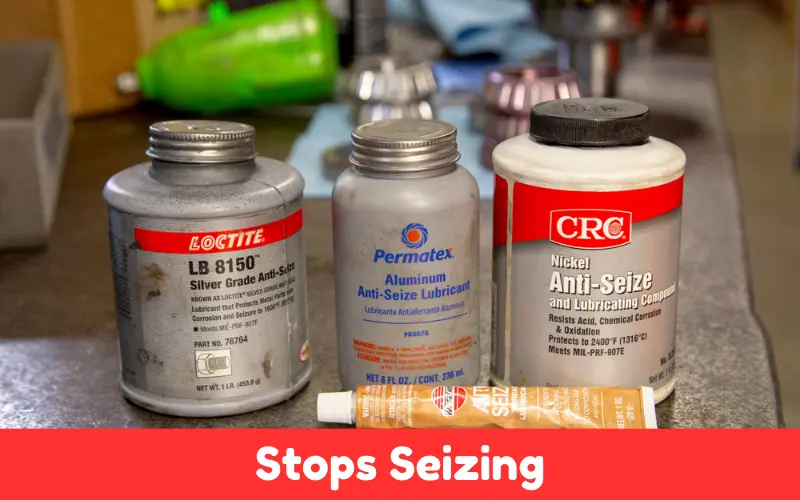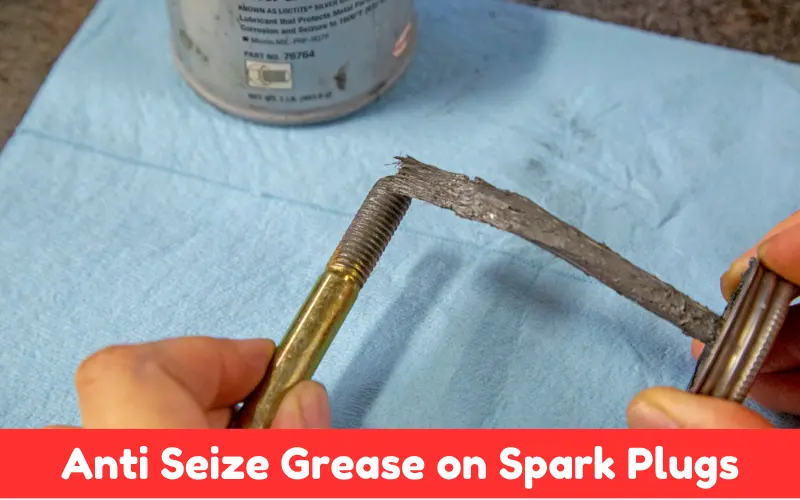If you want to keep the engine in your car or any other internal combustion engine in good shape, don’t overlook the finer details, such as anti seize grease on spark plugs.
It’s an easy process to ignore, but it will save you a lot of headaches in the future. In this guide, you will discover what anti seize grease is, why you should apply it to your spark plugs, and finally, how to do it properly.
Article Summary
What is Anti Seize Grease?
Anti Seize grease is a high temperature lubricant that helps prevent seizing, galling, and corrosion of metal parts.
A typical anti seize compound contains metallic particle pigments (generally in the size range of a few microns) of copper, aluminum, or nickel uniformly suspended in a grease base.
Compounds of this nature are engineered for extreme temperature and environmental applications. Since spark plugs face extreme temperatures, anti seize grease is a highly suitable lubricant for this application.
Types of Anti Seize Lubricants
Anti seize sprays and lubes have a low coefficient of friction, preventing seizing, galling and fretting, as well as preventing heating and corrosion on metal surfaces.
Threaded and metal connections can be safely and easily taken apart days, even years after they were assembled while exposed to higher than normal temperatures or pressures.
Here are some of the more common types:
Copper-Based Anti Seize Lubricants: These contain coarse particles of copper and work at high temperatures (up to approximately 1,800°F or 1,000°C). They are used on automotive and industrial parts where seizure from high temperatures can occur.
Nickel-Based Anti Seize: Many lubricate products, including this nickel-based variety, have been used in the manufacture of aircraft engines because of their ability to perform at extremely high temperatures (up to about 2,400°F or 1,300°C).
These are used with stainless steel or other metals or applications where corrosion resistance or high temperature performance is important.
Graphite-Based Anti Seize Lubricants: A lubricant based on graphite provides excellent lubricating characteristics and performs well in high temperature environments.
When metals are subjected to high temperatures under high loads (such as parts of braking assemblies), graphite-based lubricants can prevent galling.
Aluminum-Based Anti Seize Lubricants: These conform to ASTM D 4953 Classifications (with Canadian equivalents). They contain aluminum particles and serve general industrial uses where non reactive and high temperature resistant bearing lubricants are required.
Molybdenum Disulfide-Based Anti Seize Lubricants: Protect parts from seizing and wear under high pressure and high temperature environments.
Ceramic-Based Anti Seize Lubricants: These are used in applications subject to high temperatures (up to about 2,500°F or 1,370°C), mostly aerospace and high performance automotive.

General Purpose Anti Seize Lubricants: These are multipurpose and suitable for a wide range of temperatures and pressures. The materials generally have particles of different sizes to provide good general protection.
Because of their differing temperature resistance, pressure resistance and application materials, each type has a different application scenario. The right kind to buy depends on the scenario.
Why Use Anti Seize Grease on Spark Plugs?
They stop your spark plug from welding itself to your cylinder head over time and rusting. Anti seize grease is good in general for anything that is subjected to high frictional heating.
- Makes Removal Easier: When it comes time to remove your spark plugs, the anti seize grease lets them go easily and does not damage the threads in the cylinder head.
- Lubricates Threads: The liquid lubricant prevents wear and tear of the spark plug and cylinder head threads, extending their lifespan.
Should You Put Anti Seize on Spark Plugs?
An anti seize lubricant will help spark plugs last longer, but there are many things to watch out for. With that in mind, here are the takeaways.
Advantages
- Stops Seizing: Anti seize helps prevent the plugs from seizing in the cylinder head. This is particularly handy if you swap plugs often or work with aluminum cylinder heads.

- Eases Removal: This makes the removal of a plug easier the next time. If the plug has to be forced out, it’s better to do it when it’s cold so that you don’t risk cracking the plug or breaking it off in the cylinder head.
- Corrosion Protection: In areas where your fastener is likely to be susceptible to corrosion (such as marine environments), anti seize will slow the process of this importance.
Disadvantages
- Incorrect Heat Transfer: Some anti seize compounds can interfere with the heat transfer between the spark plug and the cylinder head. They should be applied very thinly so this won’t be an issue.
- Potential for Over Torque: Anti seize can lower friction to a low level, and that can invalidate the torque reading on the wrench. Pros will compensate for anti seize, but you likely won’t.
- Manufacturer Recommendations: Some manufacturers suggest not to use anti seize on spark plugs because plugs nowadays are manufactured to resist the conditions.
Best Practices
- Check Manufacturer Guidelines: For many vehicles, it’s not recommended to use anti seize on the spark plug threads. Check your vehicle’s service manual or manufacturer recommendations for the correct procedure for your car.
- Sparingly: Apply the anti seize very lightly and evenly, only on the threads. Don’t drop it on the electrode or the insulator.
- Anti Seize Factor: Anti seize coatings have a reduced friction coefficient, which means you’ll have to reset your torque readings to account for that. Just lower your torque by 10 to 20 percent.
Overall, anti seize is an excellent product for spark plugs, but make sure you use it properly and follow what the manufacturer specifies to ensure that your car performs to a standard and anti seize doesn’t become a hindrance.
How To Apply Anti Seize Grease on Spark Plugs
Follow these steps to ensure a proper application of anti seize grease:
1. Gather Your Materials:
- Anti seize grease (copper, aluminum, or nickel-based)
- Clean cloth
- New spark plugs
- Spark plug socket and wrench
Clean Spark Plug Threads: The plugs’ threads need to be clean before the grease is applied. Remove all dirt or contaminants with a clean cloth before proceeding.
2. Apply the Grease
Sparingly: Spray a small amount of anti seize grease onto the spark plug threads. A little goes a long way. Use a thin, even coating.
Avoid Grease On Electrodes: Grease is very important. Grease on the electrodes or the tip of the spark plug affects performance and ignition.

Installing Spark Plug: Install the spark plugs into the cylinder head using the spark plug socket and the spark plug wrench. Do not over tighten the plugs. Follow your manufacturer’s recommended torque settings.
Make Sure Installation is Correct: Make sure the spark plug is seated correctly and that there is no grease excess around the plug.
Tips for Using Anti Seize Grease
Pick the Right Kind: If your engine and hot operating conditions prefer copper–based anti seize grease, simply pack it instead of using lithium-based anti seize grease.
Less Use: An overapplication of grease can result in too much grease entering the combustion chamber, causing misfires or fouling.
Regular Servicing: Periodically check your plugs and regrease with anti seize if needed, particularly if you drive in harsh conditions.
FAQs on Anti Seize Grease on Spark Plugs
Is It Necessary To Use Anti Seize Grease On Spark Plugs?
Not always, but nevertheless, it’s highly recommended to do so for necessary reasons, such as preventing the seizure of plugs in a cylinder head and convenient plugs’ removal, threads from wearing, and corrosion.
Can Using Too Much Anti Seize Grease Cause Problems?
Yes, it is. Anti seize grease contains oils that can cause problems if they are present in a concentration that is too high in the combustion chamber. If too much grease is on the threads, eventually, it will work its way into the flame and disturb its stability. This can lead to misfires, fouling, or performance issues with the torch head. For this reason, you should always apply a thin and even coat only to the threads. Do not allow the grease to touch the electrodes or tip.
What Type of Anti Seize Grease Should I Use for Spark Plugs?
I recommend using copper-based anti seize on your engine. Of the three options, copper, aluminum, and nickel-copper will work well in most applications. If you’re running an engine at a higher temperature, like a turbocharged or high performance engine, I’d go with the nickel-based anti seize. Other than the higher temperature, it will function pretty similarly to the copper anti seize.
How Often Should I Reapply Anti Seize Grease?
Anti seize grease should be reapplied whenever you change your spark plugs. If you drive in harsh conditions frequently, it might be a good idea to check your spark plugs periodically and reapply if necessary. Follow the maintenance schedule and recommendations specified by your vehicle’s manufacturer.
Can Anti Seize Grease Affect the Torque of Spark Plugs?
Yes, using anti seize grease will reduce the torque reading when you’re trying to tighten your spark plugs. Anti seize grease provides lubrication, reducing friction, which will cause you to over torque your plugs (very slightly). When using anti seize grease, I like to be as close to the manufacturer’s torque specs as possible and possibly reduce the setting just a bit. Some spark plug manufacturers will have a guide for anti seize use when fueling the vehicle runs in the high five or low seven range.
Conclusion
By applying the correct thin film of anti seize grease to your spark plugs, you’re ensuring that your plugs don’t seize in their holes or niches.
They’ll still come out when you want them to, and that the threads remain protected from wear and damage due to corrosion.

